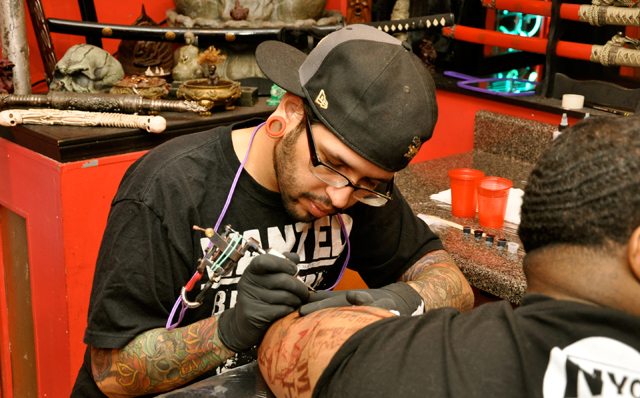Mikey Valentino, tattoo artist
By Sheilla Akwara
Once taboo, tattoos have become the “branding” of choice for many New Yorkers. In the past, tattoos were done in places where they could be easily hidden. Today you can find them on arms, necks, lower legs and, increasingly, on faces.
At the Red Dragon in the Bronx, you can walk in and choose from a selection of drawings hanging on the wall, or you can customize your tattoo. The owner, Manny Almonte, has five tattoos artists and some of them were present during the interview: Mikey Valentino, Jay Bones and Rane Felix.
It costs a minimum of $50 for an artist to work on a client. The most trendy options in the Bronx, according to Almonte, are crosses, stars, names and tramp stamps. “Tramp stamps are tattoos placed on your lower back,” he says. “They got that name because of where they are placed.” Look around, at train stations, high schools and colleges, you will be sure to see lower back tattoos, many with someone’s name, a saying or some type of flower design.

Rane Felix, tattoo artist
Crosses are increasingly popular, especially with the recent terrorist threats and natural calamities happening all over, says Almonte. For most people, a cross is a way for them to be close to some form of protection. Almonte estimates that about 35 percent of people with tattoos have tribal designs in the Bronx.
It can be hard to find a good tattoo artist with ample experience. In Manhattan, around West 4th and Saint Mark’s, there are a lot of tattoo parlors, says Almonte. Some of these are filthy and with ‘artists’ who are not truly artists, he adds. Almonte calls them scratchers. “We also have them here in the Bronx,” says Almonte. “They think that because they can draw, that they can tattoo. The state needs to limit licensing to these shops.”
Many people don’t want to pay too much for a tattoo, but given that they are permanent, it’s no time to be pinching pennies. Money should not be the focus, rather the final outcome of the design, as well as the location and reputation of the shop.
Some people experience tattoo remorse, and they want to completely erase them. For those who can’t afford laser surgery for tattoo removal, another option is cover-up. A report by the Food and Drug Administration estimated that as many as 45 million Americans have tattoos. A Harris Interactive Poll in 2003 found 16 percent of all adults and 36 percent of people 25 to 29 had at least one tattoo and 17 percent of tattooed Americans regretted it. Almonte’s shop offers tattoo cover-up services and the prices range, depending on the amount of area being worked on.
Despite the fact that it seems fairly easy for tattoo artists seem to get licensed, the industry is heavily regulated. According to health.ny.gov, one needs a permit, to follow all health regulations: wash hands and use clean gloves, use a single disposable razor while shaving the skin being tattooed, and clean the skin among many others. Permits must be posted in the shop. More information is provided on the website. The Centers for Disease Control also provides additional information about how to avoid contracting H.I.V or Hepatitis B, when getting tattoos.
The process of getting a tattoo is easy. First think of a meaningful design. Next investigate the shop and artist. You can also manage the pain. “There are creams available, and all I do is apply that on you, shade the outline of the design, wait a few minutes and then start working on the tattoo,” sahys Almonte.
Clearly it’s impossible to avoid all pain entirely, but the good news is, when the cream is applied, it numbs the area being worked on. “Even if you’ll feel something initially, the pain is not there afterwards, and when I am working on your ribs, full or half-sleeve, this can come in handy,” says Almonte.
Here are some interesting facts about tattoos found on Inkvilletattoo.com. Did you know that tattooing is illegal in seven states and heavily regulated in others? Also, the oldest tattooed body known is a Bronze Age man over 5,000 years old, coined the Iceman, and was discovered in a glacier in the mountains near Austria. Lastly, In 18th century Japan, laborers used tattoos to imitate clothing because they were ashamed to expose their naked torsos when working in hot weather.





